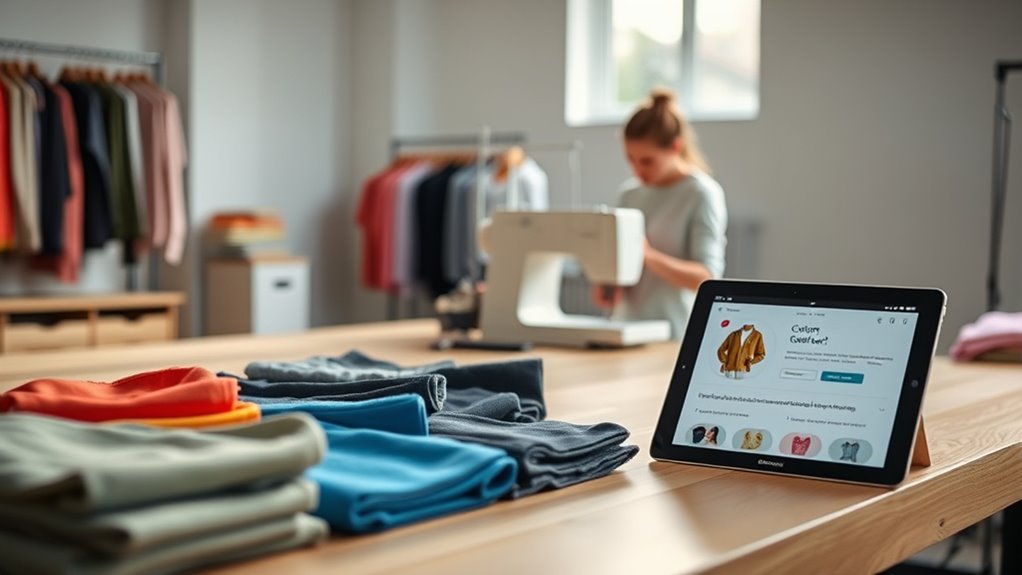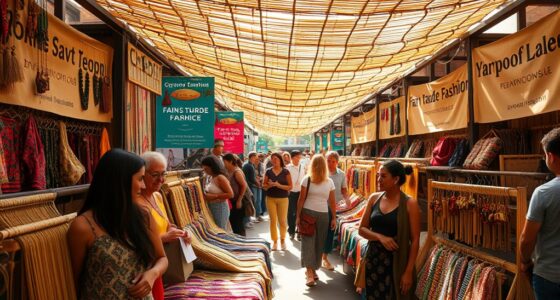On-demand and small-batch production help you cut waste by closely matching manufacturing to actual demand, avoiding excess inventory and overproduction. This approach allows you to respond quickly to customer preferences while using sustainable sourcing practices and eco-friendly materials. By reducing unsold stock, you lower disposal costs and environmental impact. If you want to learn more about how these techniques boost sustainability and streamline your supply chain, keep exploring the full benefits.
Key Takeaways
- Produces smaller, demand-aligned runs to prevent overproduction and excess inventory.
- Utilizes real-time sales data and digital tools to optimize production and reduce waste.
- Supports sustainable sourcing with eco-friendly materials, minimizing environmental impact.
- Enables product customization, decreasing unsold stock and obsolete inventory.
- Enhances supply chain flexibility, allowing quick adaptation to market changes and consumer preferences.

In today’s fast-paced market, on-demand and small-batch production have become essential strategies for businesses looking to stay competitive. These approaches allow you to respond quickly to customer preferences while minimizing excess inventory. One of the key benefits is the ability to embrace sustainable sourcing, which guarantees you’re choosing environmentally responsible materials and suppliers. When you produce only what’s needed, you reduce waste associated with overproduction and unsold stock, making your supply chain more eco-friendly. Sustainable sourcing becomes even more impactful when combined with effective inventory management, as you can track demand patterns and adjust your orders accordingly. This way, you avoid overstocking and reduce the risk of unused materials ending up in landfills.
With small-batch and on-demand production, you gain better control over your inventory. Instead of bulk ordering and storing large quantities, you produce smaller runs that match actual demand. This strategy helps you keep your storage costs low and minimizes the risk of deadstock. As a result, you’re not stuck with items that no longer sell or that may become outdated, which is a common problem in traditional mass production. You can also be more flexible when it comes to customizing products or experimenting with new designs, knowing that you won’t be left with surplus items if they don’t perform well.
Implementing these production techniques requires a shift in how you manage your supply chain. You’ll need to work closely with suppliers willing to adapt to smaller, more frequent orders, emphasizing sustainable sourcing practices. Technology plays an essential role here, as digital tools can help you forecast demand more accurately and streamline inventory management. By integrating real-time sales data and inventory tracking systems, you can produce only what’s necessary, reducing waste and promoting responsible consumption. This approach not only benefits the environment but also improves your bottom line by cutting costs associated with excess stock and obsolete inventory.
Ultimately, adopting on-demand and small-batch production methods allows you to be more agile and environmentally conscious. You’re demonstrating to your customers that you care about sustainability while also controlling costs and reducing waste. This alignment with eco-friendly practices enhances your brand reputation and appeals to increasingly conscious consumers. As you refine your inventory management and embrace sustainable sourcing, you’ll find that these practices contribute greatly to reducing waste in your operations, making your business more resilient and future-ready in today’s competitive fashion industry.
Frequently Asked Questions
How Does On-Demand Production Impact Overall Clothing Quality?
On-demand production can enhance clothing quality by prioritizing manufacturing precision, ensuring consistent craftsmanship. You’ll notice improved fabric durability because each item is made to order, reducing rushed or compromised processes. Since you’re involved in smaller batches, there’s more attention to detail, which elevates overall quality. This approach minimizes waste, and you get durable, well-made garments that meet your expectations for longevity and craftsmanship.
What Are the Main Challenges in Implementing Small-Batch Manufacturing?
You’ll face challenges with supply chain coordination and maintaining quality control when implementing small-batch manufacturing. Scaling production can be tricky, as it requires precise planning and flexible processes. You might struggle with inventory management, since small batches mean less predictability. Additionally, balancing cost-efficiency while meeting demand demands careful attention. Overcoming these hurdles involves streamlining logistics and adopting adaptable systems to guarantee consistent quality and smooth production flow.
How Can Brands Balance Cost and Sustainability With Small-Batch Strategies?
You can balance cost and sustainability by optimizing your supply chain for efficiency and reducing excess inventory. Focus on consumer engagement to align production closely with demand, minimizing waste. Embrace small-batch strategies that allow flexibility and customization, which appeals to eco-conscious customers. By streamlining logistics and fostering transparent communication, you’ll create a sustainable model that resonates with consumers while controlling costs and reducing environmental impact.
What Technological Innovations Support On-Demand Fashion Production?
Think of technology as your fashion compass. 3D printing acts like a sculptor, bringing designs to life with precision and less waste. AI-driven design serves as your creative muse, predicting trends and customizing styles effortlessly. Together, these innovations empower you to produce on-demand, reducing excess and waste while staying ahead of the curve. Embrace these tools to make fashion smarter, sustainable, and uniquely you.
How Do Consumer Preferences Influence On-Demand and Small-Batch Trends?
Your consumer behavior heavily influences on-demand and small-batch trends, as you increasingly seek personalized, unique pieces. This demand drives brands to adapt swiftly, embracing trend adaptation to meet your preferences while minimizing waste. When you prioritize sustainability and exclusivity, fashion companies respond by producing limited runs or custom items, reducing excess inventory. Your choices shape the industry’s shift toward more responsible, innovative on-demand and small-batch production methods.
Conclusion
By embracing on-demand and small-batch production, you can substantially cut down waste and make fashion more sustainable. It’s like shifting from a dial-up connection to fiber optic speed—you modernize your approach without sacrificing quality. This strategy not only benefits the planet but also keeps your brand ahead of the curve. So, don’t be a square—adopt innovative methods now, and watch your eco-conscious efforts become the talk of the town, just like a well-placed vintage record.









